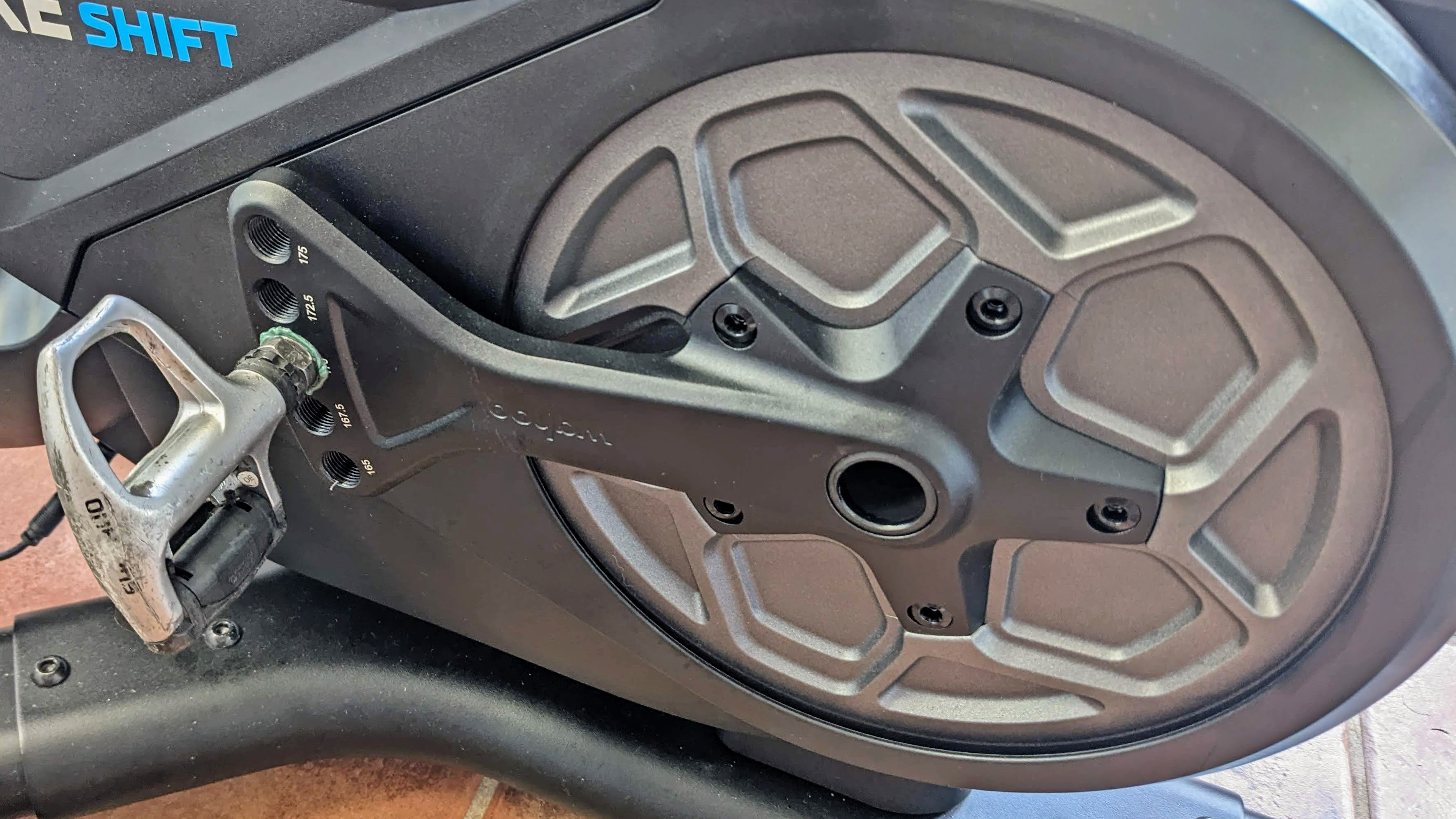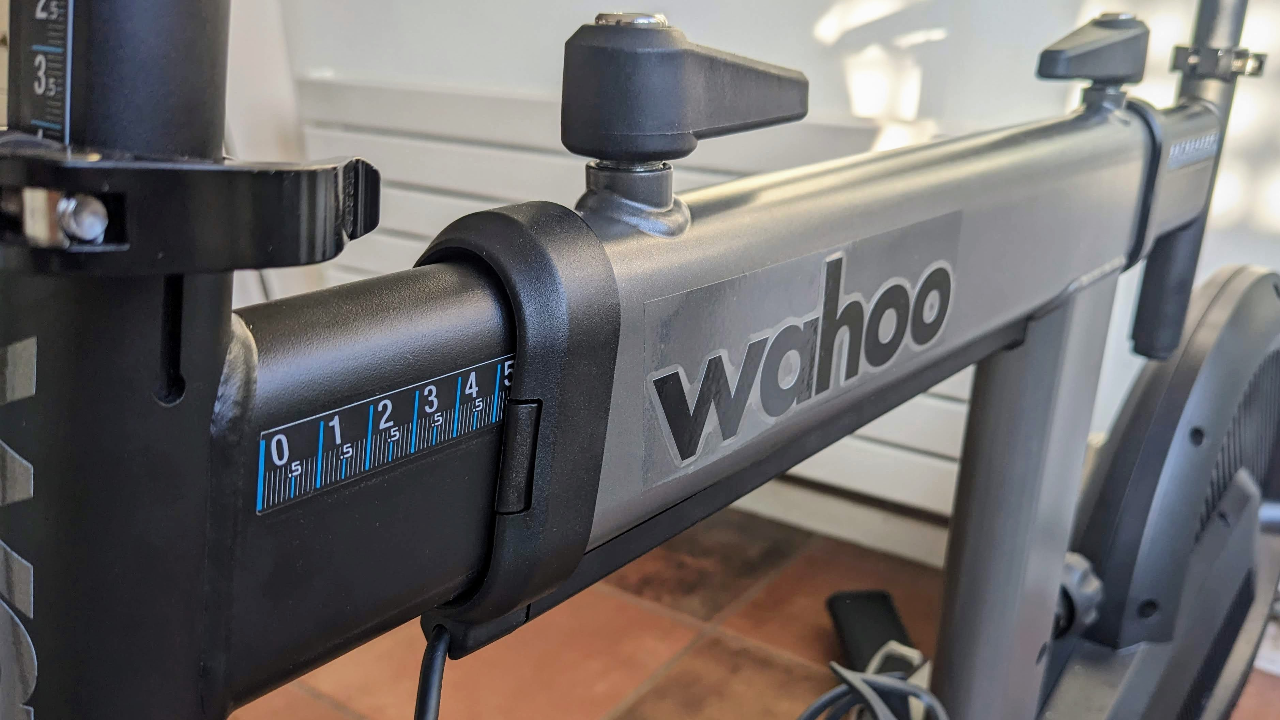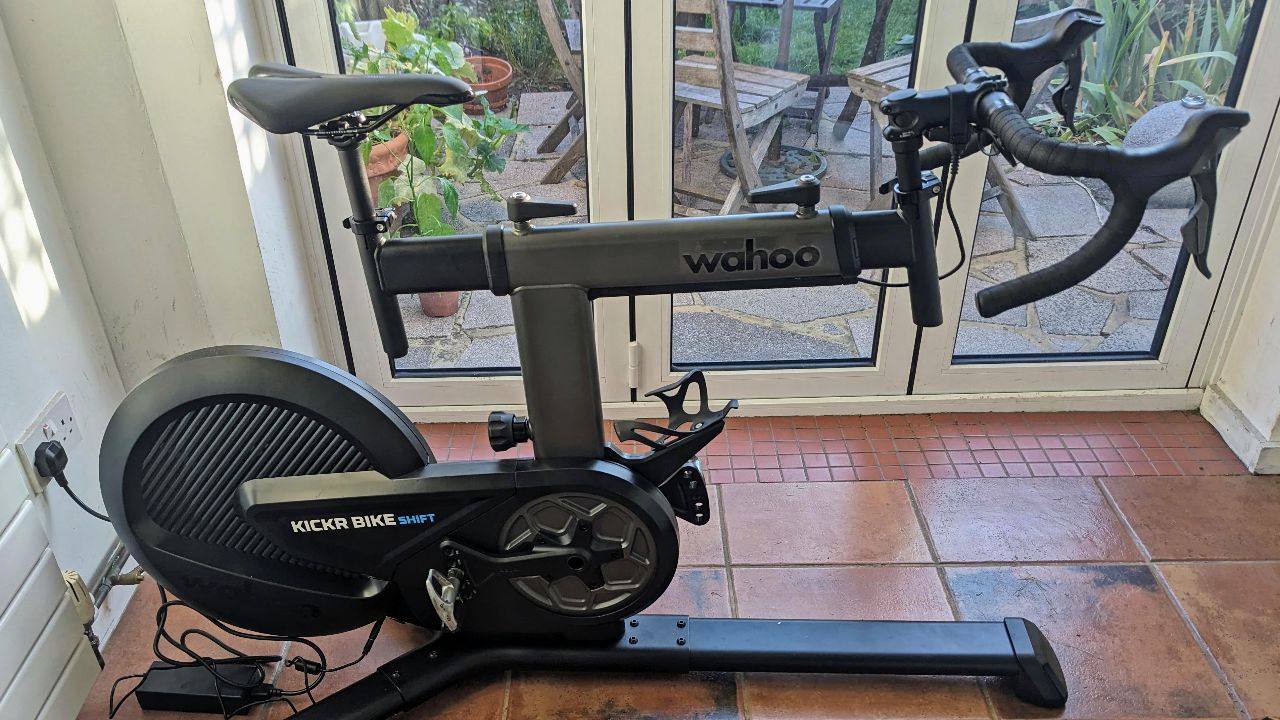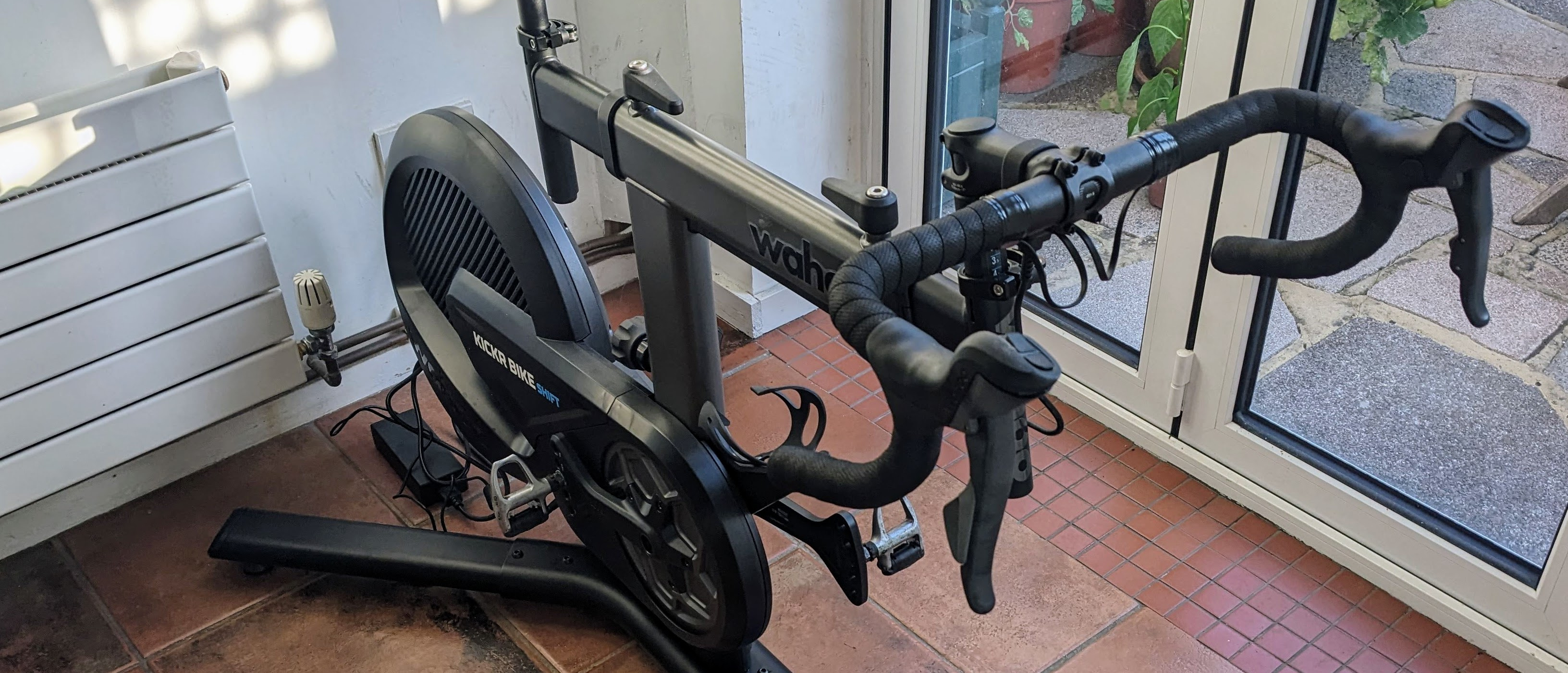Our Verdict
The Wahoo Kickr Bike Shift does most of the things the more expensive Kickr Bike V2 can, apart from tilting up and down. But if you’ve got the money to spend on the Bike Shift, why settle for second best?
For
- Maximum power outputs and simulated gradients you’ll never exceed
- Realistic ride feel
- Quiet
- Tool-free bike fit tweaking
Against
- Finishing kit feels cheap for the money
- More expensive than direct rivals
- Lack of display noticeable
You can trust Coach
When road cyclists are deciding how to train indoors, it’s worth considering smart exercise bikes alongside turbo trainers (if you have the money). The best indoor bikes match the features of the best turbo trainers and don’t require the use of your bike—a convenience for those who want to ride outdoors and train inside during the colder (or indeed hotter) seasons.
The Wattbike was the only real option if you wanted something that mimicked gear changes, until Wahoo released the Kickr Bike in 2019. As with everything the US manufacturer has released, it disrupted the market, bringing the tilting technology of its turbo training accessory the Kickr Rise to the stationary bike and increasing the realism of the ride. The Kickr Bike V2 (released in 2022) refined some of the first edition’s features but, ultimately, it was an evolution rather than a revolution, and its price of $3,999.99/£3,499 meant it remained out of reach for most.
The launch of the new, cheaper Kickr Bike Shift should therefore be exciting for those who like the idea of a standalone smart bike for indoor training, but have been put off by the cost. But is this another pioneering release from Wahoo or a flop to file alongside its Kickr Steer?
Wahoo Kickr Bike Shift: Price And Availability
The Wahoo Kickr Bike Shift was released on September 12, 2023 and costs $2,999 in the US and £2,699 in the UK; that’s $1,000/£800 less than the Wahoo Kickr Bike V2. It is the second model in Wahoo’s smart bike line-up, and is a direct competitor to the Wattbike Atom and Tacx Neo Smart Bike.
How I Tested This Bike
I’ve logged 10 hours of indoor training on Wahoo Kickr Bike Shift, including rides on virtual platforms, such as Zwift and Wahoo X, as well as structured workouts on Zwift and TrainerRoad. I have experience with most of the best turbo trainers and smart bikes, including the Wahoo Kickr Bike Shift’s direct rivals.
Wahoo Kickr Bike Shift Vs Wahoo Kickr Bike V2
To the untrained eye, the Kickr Bike Shift looks similar to its more expensive colleague, but there are differences. It has refined its five-point adjustable fit set-up (stack, reach, setback, saddle height and frame height) and five crank length possibilities, enabling you to match the geometry of your bike or professional bike fit to the nearest millimeter.

Keep looking and you’ll see where Wahoo has made changes to keep its price down. Instead of the 13lb flywheel at the rear, it has an enclosed electromagnetic brake-actioned resistance design—similar to that used by the Tacx Neo Smart bike. The Kickr Bike Shift’s frame material is steel rather than aluminum and it doesn’t have a digital display on its top tube.
Sign up for workout ideas, training advice, reviews of the latest gear and more.
Aside from visuals, it shares many of the same features as the Kickr Bike V2: power accuracy (+/- 1%), simulated gradients (between 20% to -15%), ERG easy ramp (where you can gradually build back up to a power output if you have to pause mid-interval) and in-game steering. It can connect to heart rate monitors, computers and phones via Bluetooth and ANT+; there’s also a built-in Wi-Fi receiver and direct connection that enables you to plug straight into a router and end signal drop-outs for good (although it does require the purchase of an additional $99.99/£80 accessory). The Kickr Bike Shift has a slightly lower maximum output (2,200W vs 2,500W) than the Kickr Bike V2, but good luck getting close to those heady heights!
The key difference between them is the lack of tilting on the Kickr Bike Shift. Where I would rise out of the saddle as the bike angled backward to tackle a punchy climb on the Kickr Bike V2, I tended to stay in the saddle on the Kickr Bike Shift, grinding away in a seated position and letting my quads (rather than calves) do the heavy lifting.
The Set-Up
The Kickr Bike Shift arrived in a big box and needed some assembly before it could be put to use. Since it weighs 79lb/35.8kg, it’s best to do this with someone else’s help, although I managed to carry it up one flight of stairs on my own for set-up in my home office.
Before you can get started on your first virtual ride or training session, you need to secure three stabilizing legs with the bolts and tools provided, attach the handlebars to the stem, insert the seatpost and magnetically attach the cable from the handlebar to the underside of the stem for the gear shifting. It’s fairly straightforward if you’ve done your share of flat-pack furniture building, and there are instructions included in the box.

Next, tune the smart bike’s geometry to your ideal fit. If you have a bike fit report from GURU, Retül or Trek, you can enter your numbers into the web-based wizard to get the correct set-up. If your bike fit report doesn’t fall into this category (as mine didn’t), you can insert rough figures before breaking out the tape measure to get things dialed in properly. Alternatively, there is an AI-based system where you take a photo of your bike to get a somewhat accurate fit, or use measurements of your body to get a less accurate fit.
The final step in the set-up process is tailoring the virtual drivetrain to your real-life bike. All the major shifting configurations (Shimano, SRAM and Campagnolo) are catered for, while it’s possible to refine your gearing (from the number of chainrings to the individual cassette cogs) to your heart’s content.
The Ride
The Kickr Bike Shift ticks all the boxes you’d want in a stand-alone smart bike to successfully recreate a realistic ride. During testing I found the rise and fall of virtual gradients was simulated seamlessly by the electromagnetic resistance, while it reacted to gear shifts and surges in power instantly. Its fixed base meant it lacked the range of side-to-side movement of the Kickr V6 turbo trainer, but there was a couple of millimeters of give, due to my use of a turbo trainer mat.
During an interval workout the power output remained consistent and it avoided the slips that can plague wheel-on turbo trainers with sudden changes in cadence or effort.
It wasn’t perfect. The finish kit hasn’t been improved from the Kickr Bike and cheapens the experience. The lack of display made it hard to keep track of what gear I was in when whizzing around the virtual worlds, which was particularly noticeable when I’d forgotten what chainring I was in, only to shift and get stuck in a ridiculously high gear. It also can’t simulate the gravel or cobbled roads found on Zwift, like the Tacx Neo smart bike—although I would add that this is more of a gimmick that doesn’t add much to the overall immersive experience.
The main issue with the Kickr Bike Shift is that it doesn’t include the tilt feature I found so innovative on the original Kickr Bike. I found it helped me to change my on-bike position throughout an indoor training session like I would on the road, minimizing sore spots that can occur from riding in a fixed position for hours on end and also engaging different muscle groups. Without it, the Kickr Bike Shift’s ride feel doesn’t stand out when compared with any other high-end turbo trainer or smart bike.
I appreciate Wahoo had to make cuts to get the price of its second-tier smart bike down, but it seems a shame that it didn’t just scale back the likes of gradient range or maximum power output rather than forgoing one of the Kickr Bike’s best features.
Is the Wahoo Kickr Bike Shift Worth It?

If you’re in the market for a smart bike to use for indoor training while reserving your actual bike for best, there’s a good chance that budget isn’t an issue. So why would you settle for a second-tier alternative when an extra $1,000/£800 could get you the Kickr Bike? When the cheaper Wattbike Atom and Tacx Neo Smart Bike are available too, I’m left scratching my head as to why you would opt for the Kickr Bike Shift.
The category leader, the Wattbike Atom, is at the top of the pile for a reason. It has higher capabilities than the Kickr Bike Shift in terms of maximum output (2,500W vs 2,200W) and gradient simulation (25% vs 20%) without sacrificing power accuracy (also +/- 1%). It also has a smaller footprint (50cm x 100cm) and little wheels to move it around on—ideal if your pain cave has to double up as spare room or garage.
Yes, the Wahoo Kickr Bike Shift is a solid smart bike and does everything it claims, to the incredibly high standards that we’ve come to expect from Wahoo. But it seems an unnecessary addition to the market that doesn’t do enough to make it stand head and shoulders above the rest.
Charlie Allenby is a journalist with a passion for pedalling. He contributes features and buying advice about cycling, and is Coach’s dedicated turbo trainer reviewer. He is also Coach’s chief whey and casein protein powder tester, trying as many brands as possible.
Charlie’s first book, Bike London, is out now. He has written for The Guardian, The Independent and BikeRadar, among others.


